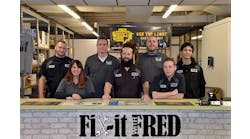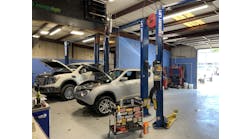Moving to a new location can mean one of two things: One, the location will bring about new customers and improve your business’ car count; or two, the location could be a bust and create stress and hassle for your original shop. While exciting, adding a second location can often be a struggle.
“The second shop is the hardest,” says Doug Hillmuth, co-founder of Hillmuth Certified Automotive in Baltimore. “When we first started, we went too big.”
After Hillmuth and his brother, William “Bill Jr.,” opened the business in 1978, the shop felt a push to grow and expand the business for those who worked in the facility. Then, the hunt for a second location came into play.
“I did have a goal, in the back of my head, for four locations,” he says.
The brothers did reach their goal of four locations, and, along the way, they learned exactly what constitutes a successful new location. The two also catered to different roles within the business: Hillmuth spent his time working on finances and overall expansion plans, while his brother worked at the shop and would make sure the operations stayed in tact, he says.
Today, Hillmuth says in order to make the business venture work, you need a plan in place for the business.
“You have to have your model,” he says. “Your processes need to be well-written and understandable and thoroughly tested in your first location.”
Hillmuth remembers the process he went through when bringing aboard a second location, and more importantly, he reflects on what the process taught him during the acquisition of his third and fourth location.
Take time to research.
Before you begin taking steps toward purchasing a new business, it’s important to really look at several components that make up the property in order to determine if it’s a good fit for your demographics. For Hillmuth, he spends roughly 3–6 months researching the property before moving forward.
“The build-up could be over years,” Hillmuth says. “With an acquisition, it could take a couple of years.”
Those components are:
1. Traffic count and City Records
In order to really understand whether or not the land will be a success for the business, Hillmuth says he looks at both traffic count—something he can get from the Department of Transportation.
“I tried to look at drive pattern on the right-hand side of the road where most people were traveling to,” Hillmuth says. “How much road frontage did I have [and] how much exposure was there on a good day because I didn’t want to be in the back of a development.”
Along with watching traffic, Hillmuth suggests checking out available documents from the county planning board to figure out what’s planned in the area.
“I would look at the traffic count and get the statistics of the travel count from that vicinity and I would get the demographics for the area by zip code,” Hillmuth says.
2. Nearby Housing
Hillmuth also looks at the area’s household income and the value of the homes within a 2- to 5-mile radius, he says. Different companies can give you access to that demographic information, Hillmuth says.
“I would look at other shops in the area and count bays and compare that to how many households with a minimum of two cars or three cars per household,” he says. “I would do a ratio between bays available in the area versus cars.
“I ran into that with the fourth location in Glenwood because it’s more rural than all.”
Develop a financial approach.
Throughout your research process, it’s important to understand the financial changes that come with starting up a new venture. Before the business is open, it’s important to look into what needs to be done and how the shop can financially prepare for those changes.
You have to know your business model, Hillmuth says.
“I used to do financial forecasting,” he says. “[I’d look at] what’s your average ticket now, what’s your location, and then what does your model say; look at your model and see if you have people in place [for the change].”
According to Hillmuth, making sure you have financial cushion is helpful for the business, as incidents can always arise.
“I went in and I borrowed extra money per capitol,” he says. “I said [to the bank], ‘This is what I need, and I needed two months worth of capital.’”
Often, it’s better to have the money sitting around, just in case a situation arises, Hillmuth says.
“I was borrowing up money to cover unexpected things, so we would have those reserves,” he says.
Plan your shop layout.
Often, there is so much to cover in regard to ensuring that the property will be a great fit for your business. In order to really get a feel for what areas to check off while in the process of moving into the shop, it’s important to consult those within the industry, as well as outside of it, Hillmuth says.
“In the beginning, it was people that had been in the business before and it was friends that had been in business and started businesses,” he says. “[It was] just taking the wisdom from others that had been in business.”
One suggestion that really helped Hillmuth capture what the business would look like is getting in contact with equipment suppliers.
“Equipment suppliers are known to go into a brand new place and [suggest] the best use of the area that you’re trying to facilitate,” Hillmuth says.
After connecting with various equipment suppliers, he was able to track down what was necessary for the shop.
Equipment suppliers helped Hillmuth visualize how to lay out his shop, such as making suggestions on where to put noisy equipment or the impact of placing bays in a curve in contrast to a straight line.
“It’s little things like that,” he says. “They could really look at a facility and say, ‘Here’s how you can get the best use of the repair shop.’”



